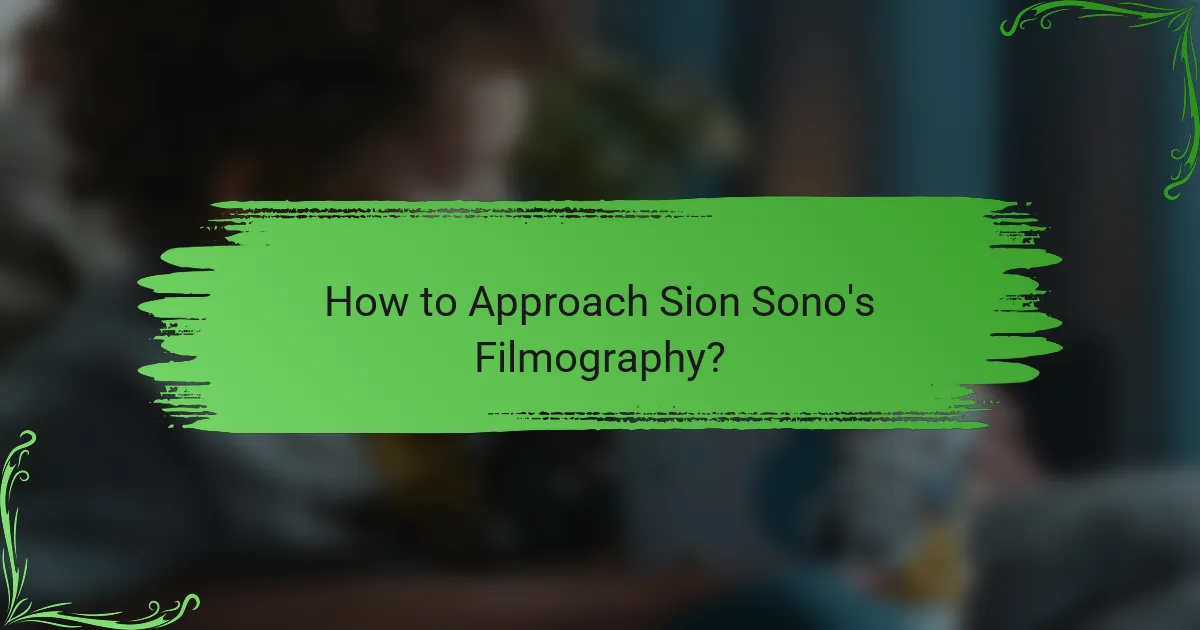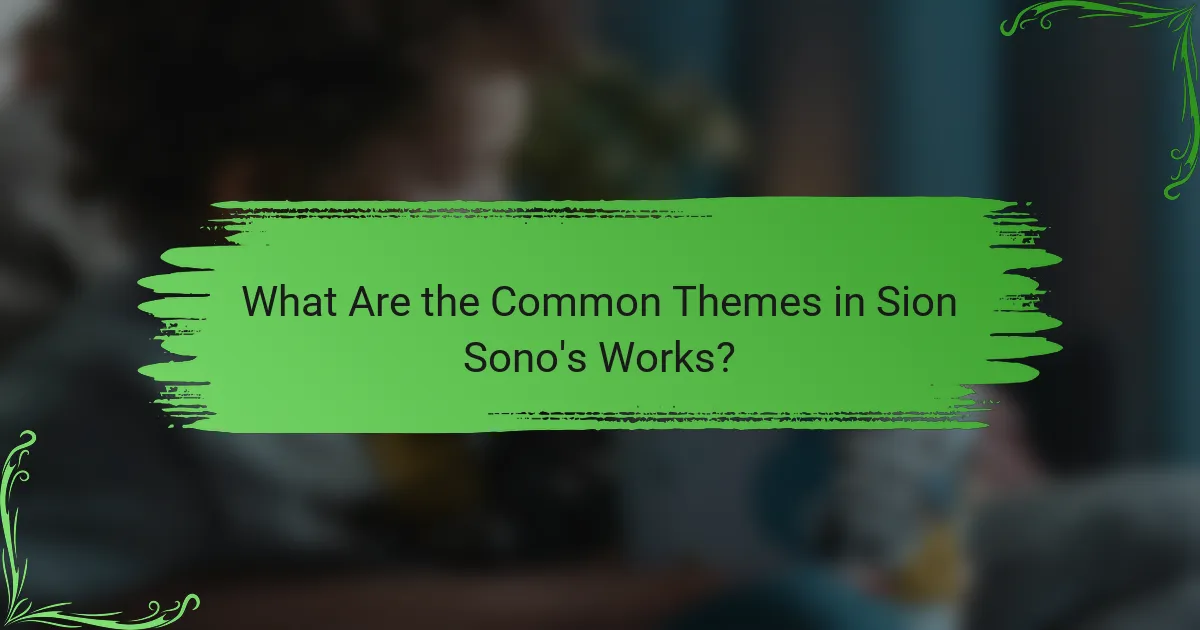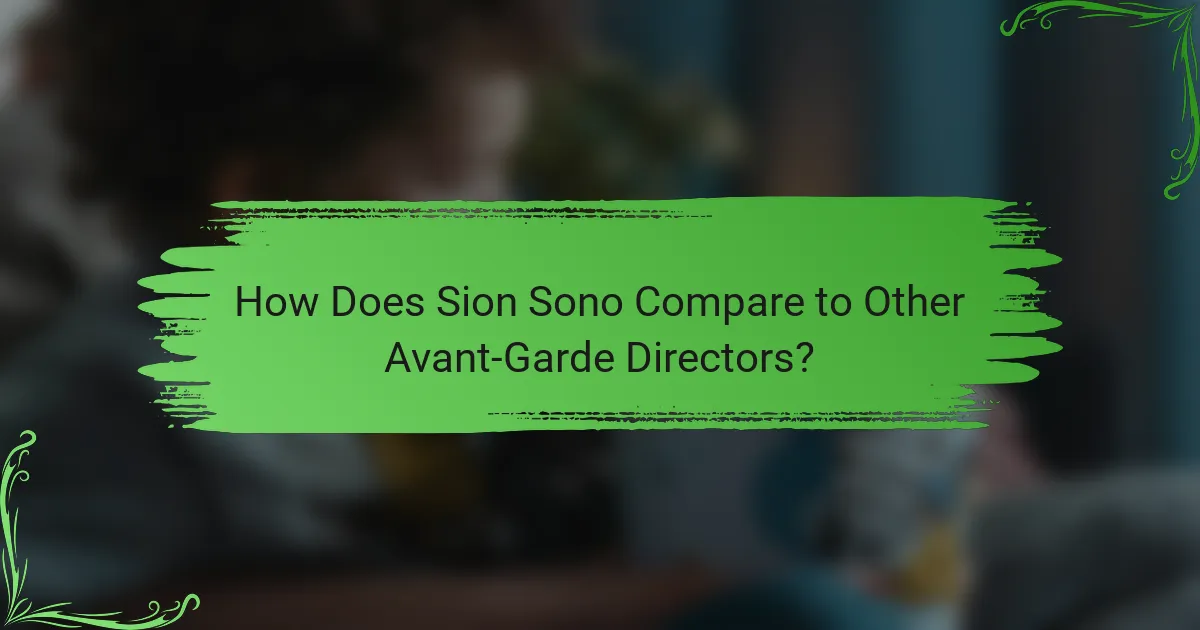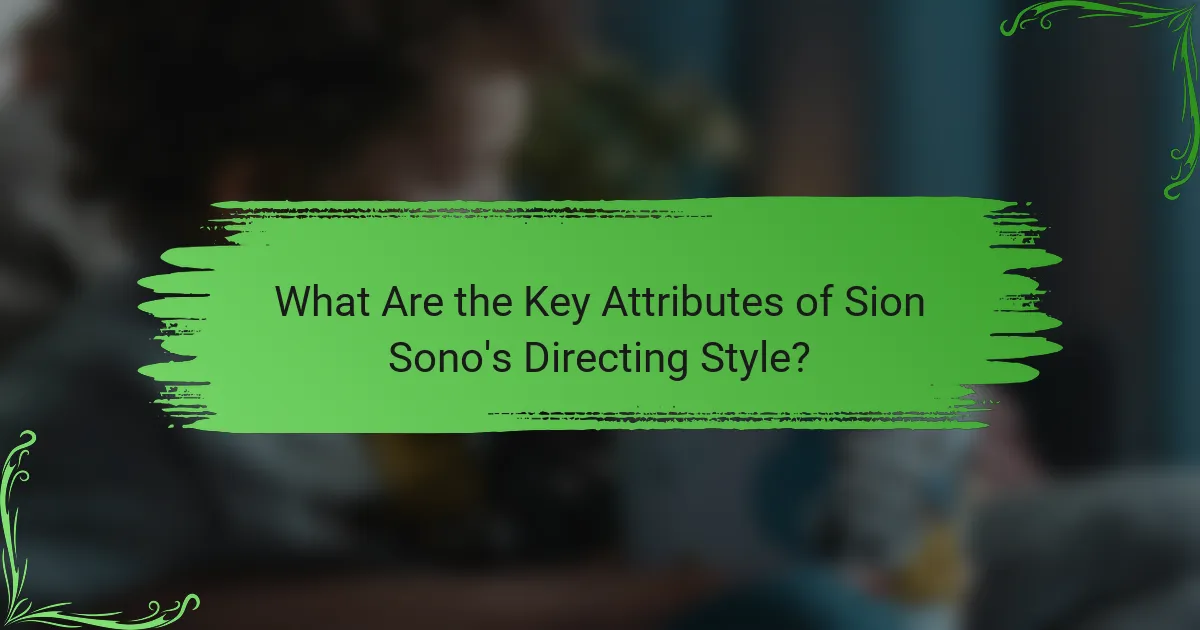Sion Sono’s films are a captivating fusion of surrealism, dark humor, and incisive social commentary, making them essential viewing for avant-garde enthusiasts. His unconventional narrative structures and genre-blending techniques challenge traditional filmmaking norms, offering a rich and thought-provoking experience. Delving into his unique storytelling style will deepen your appreciation for the complexities and themes present in his work.

What Are the Best Sion Sono Films for Avant-Garde Enthusiasts?
Sion Sono’s films are a unique blend of surrealism, dark humor, and social commentary, making them a treasure trove for avant-garde enthusiasts. His works often challenge conventional storytelling and explore complex themes, providing a rich viewing experience for those seeking something unconventional.
Suicide Club (2001)
Suicide Club is a provocative exploration of youth culture and societal apathy in Japan. The film opens with a shocking mass suicide, setting the tone for a narrative that delves into the reasons behind such despair. Its non-linear storytelling and surreal imagery challenge viewers to reflect on the darker aspects of modern life.
The film’s unique approach to horror and social critique has made it a cult classic, often discussed in the context of psychological and existential themes. Its bold visual style and unsettling atmosphere are hallmarks of Sono’s avant-garde sensibility.
Cold Fish (2010)
Cold Fish is a disturbing yet captivating tale that examines the underbelly of the fish market industry and domestic violence. The story follows a mild-mannered man who becomes entangled with a psychopathic fish shop owner, leading to a series of violent and shocking events. This film is notable for its intense character development and moral ambiguity.
With its graphic violence and dark humor, Cold Fish pushes boundaries and invites viewers to confront uncomfortable truths about human nature. Its exploration of power dynamics and the grotesque aspects of everyday life exemplifies Sono’s avant-garde style.
Tag (2015)
Tag is a visually striking film that plays with the concept of reality and identity through a fast-paced narrative. The story begins with a group of schoolgirls being brutally attacked, leading to a surreal journey that blurs the lines between life and death. Its rapid shifts in tone and perspective create a disorienting experience for the audience.
This film is a commentary on societal expectations and the fragility of existence, wrapped in a unique visual aesthetic. Tag’s innovative storytelling and shocking imagery make it a standout piece for those interested in avant-garde cinema.
Love Exposure (2008)
Love Exposure is an epic exploration of love, faith, and sexuality, spanning over four hours. The film follows a young man who becomes embroiled in a world of religious fanaticism and sexual obsession, leading to a complex narrative filled with unexpected twists. Its ambitious scope and eclectic style showcase Sono’s artistic vision.
The film’s blend of melodrama, action, and philosophical inquiry creates a rich tapestry that challenges viewers to engage with its themes on multiple levels. Love Exposure is often hailed as one of Sono’s masterpieces, embodying the essence of avant-garde storytelling.
Antiporno (2016)
Antiporno is a bold critique of the adult film industry and societal norms surrounding sexuality. The film centers on a [censured] actress who grapples with her identity and the expectations placed upon her. Its experimental structure and provocative content invite viewers to question the nature of desire and exploitation.
With its striking visuals and subversive themes, Antiporno stands out as a daring work that challenges conventional narratives about sex and power. This film is essential viewing for those interested in the intersection of art and social commentary within the avant-garde realm.

Why Are Sion Sono’s Films Unique?
Sion Sono’s films stand out due to their unconventional narrative structures, genre-blending techniques, and incisive social commentary. These elements create a distinctive viewing experience that challenges traditional filmmaking norms and engages audiences on multiple levels.
Non-linear storytelling
Sion Sono often employs non-linear storytelling, which disrupts the chronological flow of events. This technique invites viewers to piece together the narrative, enhancing engagement and encouraging deeper analysis. Films like “Love Exposure” exemplify this approach, weaving together multiple timelines and perspectives.
When watching his films, be prepared for abrupt shifts in time and focus. This can be disorienting but ultimately rewarding as it reveals character motivations and thematic depth. Expect to revisit scenes to fully grasp their significance within the larger narrative.
Blending genres
Another hallmark of Sono’s work is his ability to blend genres seamlessly. He often combines elements of horror, drama, romance, and comedy, creating a unique cinematic experience that defies categorization. For instance, “Suicide Club” merges horror with social satire, provoking thought while delivering shock value.
Viewers should approach his films with an open mind, as genre expectations may be subverted. This blending not only enhances storytelling but also broadens the emotional range of the films, making them resonate with diverse audiences.
Social commentary
Sion Sono’s films frequently incorporate sharp social commentary, addressing issues such as identity, societal norms, and the human condition. His work often reflects the complexities of contemporary Japanese society, challenging viewers to confront uncomfortable truths. “Cold Fish” serves as a critique of consumerism and moral decay, using its narrative to spark discussion.
When engaging with his films, consider the underlying messages and how they relate to broader societal themes. This awareness can deepen your appreciation of his artistry and the provocative nature of his storytelling.

How to Approach Sion Sono’s Filmography?
To effectively engage with Sion Sono’s filmography, focus on his unique storytelling style, which often blends genres and themes. Understanding his approach will enhance your viewing experience and appreciation of his avant-garde films.
Start with key themes
Sion Sono’s films frequently explore themes of love, violence, and the human condition, often juxtaposed in unexpected ways. His works can be characterized by a blend of surrealism and realism, challenging viewers to confront uncomfortable truths. Pay attention to recurring motifs such as isolation and societal critique, which are prevalent across his body of work.
For instance, films like “Love Exposure” delve into the complexities of love and obsession, while “Suicide Club” critiques modern society’s desensitization to violence. Identifying these themes will provide a deeper understanding of his narrative choices.
Explore character studies
Character development is central to Sion Sono’s storytelling, often featuring deeply flawed individuals navigating chaotic circumstances. His characters are typically multi-dimensional, reflecting a range of emotions and motivations that resonate with audiences. Look for how their journeys unfold and intersect, revealing broader societal issues.
In “Cold Fish,” for example, the protagonist’s transformation from a meek fish store owner to a complicit participant in crime illustrates the impact of external pressures on personal morality. Analyzing character arcs can reveal the underlying messages in Sono’s films.
Understand cultural context
To fully appreciate Sion Sono’s films, it’s essential to grasp the cultural and social contexts of Japan. His works often reflect contemporary issues, such as the pressures of modern life and the influence of technology on human relationships. Familiarize yourself with Japanese societal norms and historical events that may inform his narratives.
For instance, “Tokyo Tribe” incorporates elements of hip-hop culture and urban life, showcasing the vibrancy and struggles of Japanese youth. Recognizing these cultural references will enhance your understanding of the themes and character motivations in his films.

What Are the Common Themes in Sion Sono’s Works?
Sion Sono’s films often explore themes of isolation, violence, and complex human emotions, reflecting the darker aspects of society and personal relationships. His unique storytelling combines surrealism with raw, emotional narratives that challenge conventional filmmaking.
Isolation and alienation
Isolation and alienation are prevalent themes in Sion Sono’s works, often depicted through characters who feel disconnected from society. This sense of estrangement can manifest in various forms, such as physical separation, emotional detachment, or societal rejection.
For example, in “Love Exposure,” the protagonist grapples with his identity and relationships, leading to a profound sense of loneliness. Sono’s portrayal of these themes resonates with audiences, inviting them to reflect on their own experiences of isolation.
Violence and absurdity
Violence and absurdity frequently intersect in Sion Sono’s films, creating a jarring yet thought-provoking viewing experience. His use of exaggerated violence often serves to highlight the absurdity of human behavior and societal norms.
In “Suicide Club,” the shocking depiction of mass suicides critiques modern life’s desensitization to violence. This blend of brutality and dark humor forces viewers to confront uncomfortable truths about society’s moral fabric.
Love and obsession
Love and obsession are central to many of Sono’s narratives, exploring the fine line between passion and madness. His characters often become consumed by their desires, leading to destructive outcomes that challenge conventional notions of love.
In “Cold Fish,” the story delves into the complexities of love intertwined with obsession, showcasing how these emotions can spiral into violence. Sono’s exploration of these themes invites viewers to question the nature of their own relationships and desires.

How Does Sion Sono Compare to Other Avant-Garde Directors?
Sion Sono stands out among avant-garde directors for his unique blend of genres, emotional depth, and surreal storytelling. While he shares thematic elements with other notable directors, his distinctive style and cultural context set him apart in the realm of experimental cinema.
Comparison with Takashi Miike
Sion Sono and Takashi Miike both push boundaries in Japanese cinema, yet their approaches differ significantly. Miike is known for his prolific output and versatility, often blending horror, action, and comedy in a single film. In contrast, Sono tends to focus more on the emotional and psychological aspects of his characters, often exploring themes of love and despair.
While Miike’s films can be frenetic and chaotic, Sono’s work often carries a more introspective tone. For example, Miike’s “Audition” is a stark horror film, whereas Sono’s “Love Exposure” combines romance with a deep exploration of faith and identity, showcasing his unique narrative style.
Comparison with Lars von Trier
Sion Sono and Lars von Trier are both known for their provocative storytelling and willingness to tackle uncomfortable subjects. However, their styles reflect different cultural backgrounds and cinematic traditions. Von Trier often employs a more nihilistic and bleak approach, while Sono infuses his films with a sense of hope and redemption, even amidst chaos.
For instance, von Trier’s “Antichrist” presents a grim view of human nature, while Sono’s “Cold Fish” critiques societal norms through a lens of dark humor and absurdity. This contrast highlights how both directors engage with similar themes but arrive at different emotional conclusions.
Comparison with David Lynch
Sion Sono and David Lynch share a penchant for surrealism and dreamlike narratives, often blurring the lines between reality and fantasy. Both directors create atmospheres that challenge viewers’ perceptions, yet their storytelling techniques diverge. Lynch’s work frequently emphasizes mood and visual symbolism, while Sono often incorporates more explicit narrative arcs and character development.
An example of this difference can be seen in Lynch’s “Mulholland Drive,” which relies heavily on ambiguous storytelling, whereas Sono’s “Suicide Club” presents a more direct commentary on societal issues. This distinction illustrates how both directors utilize avant-garde elements to explore complex themes, albeit through different lenses.

What Are the Key Attributes of Sion Sono’s Directing Style?
Sion Sono’s directing style is characterized by its bold visual storytelling, unconventional narratives, and a unique blend of genres. His films often explore themes of love, violence, and existentialism, using striking imagery and emotional depth to engage viewers.
Innovative Narrative Techniques
Sion Sono frequently employs non-linear storytelling and unexpected plot twists, which challenge traditional cinematic structures. His films often weave together multiple storylines, creating a rich tapestry of interconnected themes and characters. This approach keeps audiences engaged and encourages them to think critically about the narrative.
Visual Aesthetics
The visual style of Sono’s films is marked by vibrant colors, dynamic camera movements, and striking compositions. He often uses contrasting imagery to evoke strong emotional responses, blending the surreal with the mundane. This distinct aesthetic enhances the overall impact of his stories and leaves a lasting impression on viewers.
Exploration of Dark Themes
Many of Sono’s works delve into dark and controversial subjects, including violence, mental illness, and societal issues. He does not shy away from depicting uncomfortable realities, often using shock value to provoke thought and discussion. This fearless exploration of taboo topics sets his films apart and resonates with avant-garde enthusiasts.
Character-Driven Stories
Character development is central to Sono’s films, with complex protagonists who often grapple with their inner demons. His characters are multifaceted, reflecting a range of human emotions and experiences. This depth allows audiences to connect with them on a personal level, enhancing the emotional weight of the narrative.
